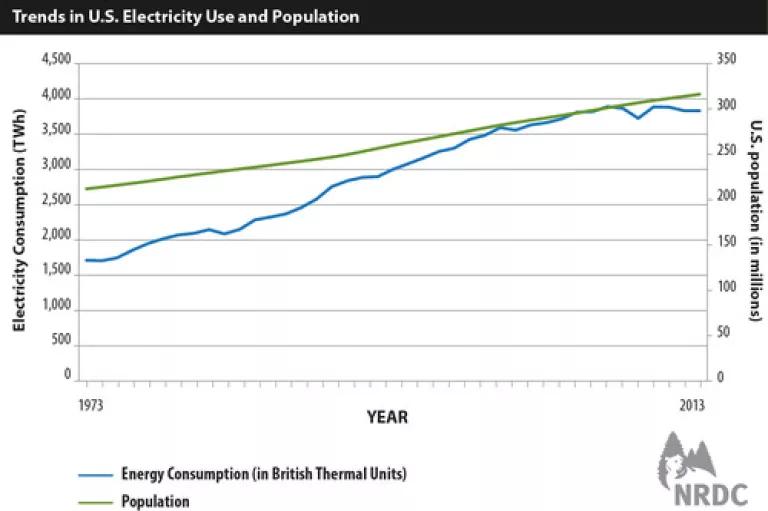
If you’ve been listening to the candidates in this election season, you’re likely to be pretty depressed about the nation’s energy future (and present). The typical attack ad these days is a litany of complaints about energy prices, security and reliability. But despite all these gloom and doom claims, it just ain’t so, as a new NRDC report released today
shows in analyzing the latest available data from government and other sources.
Here are some of the highlights from NRDC’s 2nd Annual Energy Report, “Positive Energy Trends Bode Well for U.S. Security and the Economy,” which underscores that the economic and environmental performance of America's energy systems has never been better:
- Forty years of sustained improvements in the productivity of energy use have made energy efficiency not just America’s largest single-energy resource, but a resource whose cumulative contributions to the nation’s energy needs now exceed those of all competitors, from oil and coal to natural gas and nuclear power. This means that when we use energy smarter, we don’t need to generate as much of it or purchase dirty resources like coal and oil.
- Total U.S. energy use peaked in 2007 and has trended downward since. Despite a small 2.8 percent uptick in 2013, the total still was below the level recorded a full decade earlier. Any lockstep linkage between economic growth and total energy use ended almost 40 years ago.
- Americans rely increasingly on electricity to power their homes, offices and factories. Yet since 2000, for the first time in modern history, the national growth rate for electricity consumption has dropped below that of the population for an extended period, thanks in large part to our increased energy efficiency (see chart). From 2000 to 2013, electricity consumption rose by a total of less than 7 percent, with a miniscule average annual growth rate of about 0.5 percent, even as the population grew by about twice that rate during the same period. NRDC is working with the nation’s utilities on new business models so they won’t need growth in electricity use in order to prosper.

- In June 2013, President Obama set a goal of cutting 3 billion tons of carbon pollution by 2030 through his administration’s efficiency standards for appliances and federal buildings. We’re already two-thirds of the way there, and the resulting reductions in our energy bills will exceed $4 billion.
- The amount of oil used in U.S. vehicles, homes, and businesses rose slightly in 2013 (about 1.5 percent), but is still down almost 12 percent from its 2005 peak. Surprisingly, 2012 oil use was lower than in 1973 (when the nation’s economy was only about one-third its current size), as we reported last year in “America’s (Amazingly) Good Energy News.” Lowering our reliance on oil reduces our need to import it from unstable overseas locations, too.
- Wind power has dominated the nation’s renewable energy growth since 2000, with a 30-fold increase in its share of generating America’s electricity. By 2013, wind was providing more than 4 percent of U.S. electric generation, and the absolute increase in wind generation from 2000 to 2013 was almost five times greater than the increase in nuclear generation over the same period.
- Solar is surging too, and in June 2014, for the first time in U.S. history, the U.S. Department of Energy also recently reported that hydropower generation over a full year was less than the combined contribution of other renewable electricity sources (including wind, solar and geothermal).
Looking ahead
But the best is yet to come, in terms of mobilizing clean energy resources to reduce carbon pollution. The U.S. Environmental Protection Agency proposed power plant standards in June 2014 that will keep more than 5.3 billion tons of carbon dioxide (CO2) out of the atmosphere by 2030. Put differently, in just 16 years, the standards will reduce harmful emissions from America’s power plants by 30 percent compared to 2005 levels. And because the EPA proposal calls for states to be credited for energy efficiency improvements in all sectors of the economy, EPA expects that electricity bills would drop as a result (by about 8 percent). For the average customer, that represents an annual savings of about $100.
EPA’s findings are one more reminder that progress toward a clean energy economy goes hand-in-hand with economic health more broadly, and America’s success in linking them will help inspire worldwide progress toward stabilizing atmospheric concentrations of greenhouse gases.
And, as NRDC’s new report shows, fortunately we’re already leading the way down the path to more stability in America’s economy and security – despite the fear-mongering that all those candidates want you to believe.
